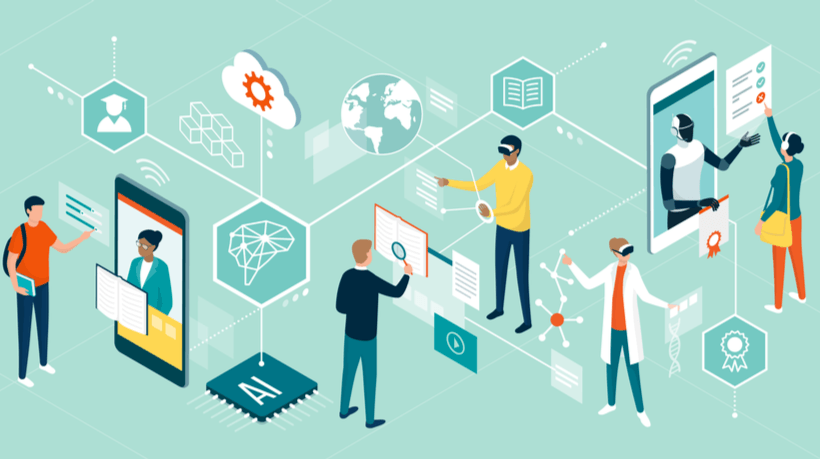Corporate Learning And Development Myths Called Into Question This Year
Global organizations are starting to realize the true value of employee training and development for future readiness. This is amply evident from the unprecedented growth of the global eLearning market which is expected to reach $325 billion by 2025 up from $107 billion in 2015, according to Research and Markets.
While, on one hand, there’s increased adoption of technology-enabled learning in the workplace, organizations still struggle to see the value of investing in corporate L&D programs, especially when it comes to Return On Investment (ROI). Thus, leading to wrongfully founded fears about corporate L&D amidst the organizations and employees alike. Most of these often tend to be learning myths that hinder employee career growth and development, improving customer experience and maximizing business results.
In his latest book titled: Millennials, Goldfish & Other Training Misconceptions: Debunking Learning Myths and Superstitions, Clark Quinn gives the lowdown on several myths that still persist in eLearning design practices and the erroneous beliefs and superstitions about learning in general. An excerpt from the book reads: "Many myths persist despite the evidence, and many of them affect the learning and training industry. Despite research results and considerable attention, large numbers of myths are still endorsed by the public. Myths are beliefs that are prevalent despite repeated evidence that they’re wrong. These learning myths cause us to invest in approaches that either waste time and money or hinder learning, which harms both the field and our learners. It’s like we suddenly decided to go back to astrology instead of astronomy!"
Based on the LinkedIn post by Michelle Ockers, L&D Strategist and Modern Workplace Learning Practitioner, below is a list of 8 of the most widely used corporate Learning and Development myths:
1. People Remember 10% Of What They Read And 20% Of What They See
People do not remember 10% of what they read, 20% of what they see, or 30% of what they hear. This is blatant misinformation that has been perpetuated for far too long. The efficiency or credibility of learning methods cannot be generalized into such percentages, because the results of learning are drawn from many variables in order to provide such exact numbers, let alone make it into some sort of rule.
However, this myth has been used and reused and presented in different variations over and over for many years, along with an adulterated version of Dale’s Cone. So much so that even a Google search gives 80% misleading information for Dale’s Cone. Edgar Dale, an American educator, developed the Dale’s Cone of Experience, which had no numbers, unlike today’s corrupted versions. He also maintained that the 'cone' is not to be taken too literally.
Moreover, the idea of comparing different learning methods is ludicrous. The criteria of measurement often drive the final learning outcome and it doesn’t make sense to compare the different methods using the same test. The propagation of this myth is devastating, and not restricted to the English-speaking world.
2. Everyone Has A Learning Style
Will learners learn better if taught using their specific learning styles? If you answered yes, unfortunately, you’re terribly misinformed, but not alone.
The learning styles myth emerges from the theory that people learn and retain knowledge better when presented using a specific and preferred delivery method. The widely known classifications being visual, auditory, and kinaesthetic. The myth of learning styles is quite appealing, considering that people have differing backgrounds, rates of learning/retention, and even their own preferred way of receiving knowledge. But, this is not true.
According to cognitive psychologist Dr. Harold Pashler’s findings after reviewing decades worth of research, there is no sufficient evidence-base to justify using learning styles into general educational practice. And that educational resources would be better assigned to other scientifically-proven educational practices.
3. Flexible Or Mobile Learning Happens ‘Anytime-Anywhere’
This may not be old enough to be classified as a myth, but the misconception that flexible/mobile learning takes place ‘anytime-anywhere’ is highly debatable according to the latest research. Head of Education at the University of Wollongong, Professor Sue Bennett's research suggests that learning is never without context and always takes place ‘sometime-somewhere’, highlighting the importance of context in learning.
Contextual analysis research dates back to the 1960s, providing a method for examining the factors influencing an individual’s experiences with products to develop better ones that will complement their lifestyles. Context is "a multilevel body of factors in which learning and performance are embedded" (Tessmer & Richey, 1997). Understanding context gives more insights into the development of better integrated performance-enhancement solutions.
4. You Can’t Teach An Old Dog New Tricks
Wait, but neuroplasticity says that you can teach a very old, bad-tempered, three-legged old mutt, a bunch of new tricks.
Neuroplasticity can be simply defined as the growth and rewiring of brain cells. Just like we can build muscles through weight training and exercise, our nerve cells grow and develop better connectivity through mental exercise. So, in effect, our brain rewires itself through our experiences in learning. Besides genetic factors, neuroplasticity is also affected by the environment we live in and our reaction to that environment.
So, contrary to the popular myth, our brains are not hardwired at birth. They are like malleable plastic, with changes occurring first at birth when our immature brain organizes itself unless we suffer a brain injury, throughout our adulthood whenever we learn something new.
5. A Definitive Model For Learning Success is 70:20:10
The learning industry has long debated the foundations and effectiveness of the 70-20-10 ratio, which has been applied to management and leadership development. It claims that 70% of learning happens on the job, 20% comes from people and 10% happens through learning activities.
Although many learning professionals abide by this model, many more are on a warpath to debunk it. So, is 70:20:10 a myth or not? Well, there is no definitive answer; especially, considering the new research conducted by Towards Maturity led by Charles Jennings. According to the study, 90% of employees state collaboration as essential to do their job, while 37% rate formal learning as essential. And only 47% of L&D professionals state their approach is influenced by models like 70:20:10.
Research co-author Charles Jennings, says: "Changing workplace dynamics have meant that L&D is now increasingly looking to embrace the ideas behind the 70:20:10 model. However, as interest has increased, a number of myths around it have gained momentum and distracted L&D from focusing on the holistic ‘100’ needed to deliver individual and organizational performance."
6. Our Attention Span Is Shorter Than That Of A Goldfish
First of all, we are not goldfish. And, second of all, there’s no research-based evidence that goldfish have attention spans of 9 seconds. Moreover, there’s no satisfactory evidence to even verify that we—humans—can only focus for 8 seconds. In our connected world of smartphones and social media, it just feels harder to remain focused.
The first report that propagated this myth was in 2015. The Consumer Insights team of Microsoft Canada surveyed 2000 Canadians and studied the brain activity of 112 individuals. But, BBC reporter Simon Maybin found out that the origins of the numbers cited could not be traced.
According to Psychology Lecturer, at The Open University, Dr. Gemma Briggs says: “I don't think that's (the idea of attention spans getting shorter) true at all. Simply because I don't think that that's something that psychologists or people interested in attention would try and measure and quantify in that way."
7. Models Like MBTI, TMI, OSI, LSI & DiSC Are Key To Training
We have all, at one point or another, been asked to take a personality assessment test such as the Myers-Briggs Type Indicator (MBTI) or a derivative of the same. MBTI has been propagated across Western culture for many decades, but the basis of it is nothing more than pseudo-science.
The credibility of the test often comes under scrutiny, given that half of the test subjects give different results on different days.
Annie Murphy Paul, the former Senior Editor at Psychology Today, writes in her book, The Cult of Personality Testing, about debunking personality testing. She states: "In personality testing, reliability means getting consistent results over time, or similar scores when rated by multiple people who know me well. As my inconsistent scores foreshadowed, the MBTI does poorly on reliability. Research shows that as many as three-quarters of test takers achieve a different personality type when tested again."
It’s quite appalling when you consider how widely these types of tests are used in recruiting and other activities; when instead, the tests should be based on scientific evidence. There are several similar tests and models that are still unproven ranging from IQ tests to DiSC profile and more.
8. It’s Important To Follow Every Trend In L&D
This is likely the most common and widely accepted myth across the learning industry. Every year, there are a host of prediction lists, top learning trends lists and so on. But, with everyone following every other trend out there, where is that going to get you? Nowhere is the correct answer. Maybe if L&D professionals reflect on the past few years, they would realize that most of these lists are more or less similar year-to-year, which indicates that they’re looking in the wrong direction.
One of the key objectives of L&D is essentially to add value to a business. This can primarily be done through identifying skills gaps in the workforce and leveraging learning technology to fill that gap effectively. Since results often come from deep personal insights and not from the latest fancy trends. Technological advancements are critical for improving learning capabilities, but what’s more important is to understand the world of business and align L&D accordingly.
The debunking and disproving of continued learning myths and wrongful practices are both parts of an ongoing process and a key challenge in order to highlight the importance of Learning and Development. It is up to the L&D professionals to curb the use of such convenient myths and think critically about learning practices as well as, staying informed about the latest research and applying research-backed practices to promote a wholesome learning culture.
Are there any learning myths that you want to debunk?










